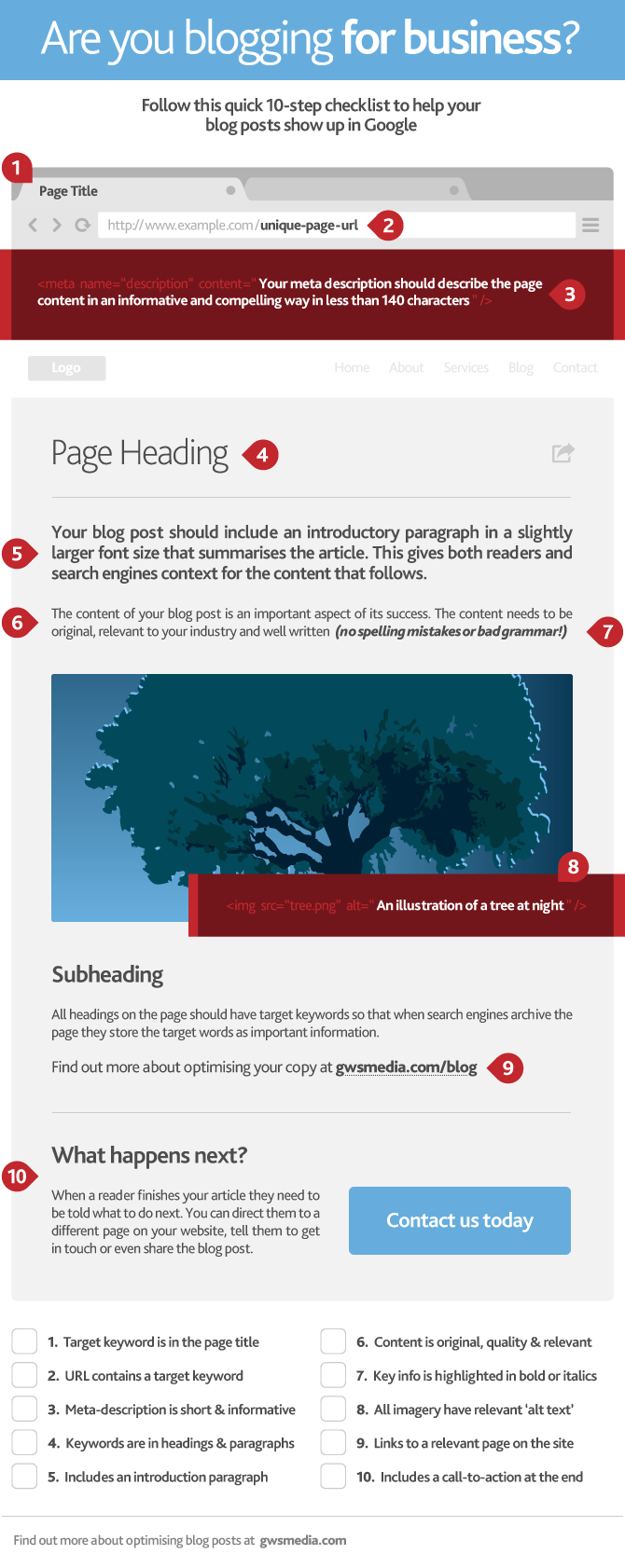Blogging is often an integral part of a B2B marketing strategy.
It is easy to see why; but with so much ‘blog noise’ out there, there is a risk that your post will be overlooked.
And if the post is found, will it succeed?
Check out this quick and easy infographic checklist to guide you to user/search engine success:

Keyword Research
Do people seek what you create? Conduct some on-the-spot keyword research to ensure you are producing content that will get traffic. Remember to only use this as a guide, write naturally and do not keyword stuff!
Page Title
The search engines give special consideration to the Page Title. It should a clear indication on the subject matter of the page. The blue text that links to your site from the Search Engine Results Pages (SERPS) is taken from the title tag.
Where do I change this? It varies depending on CMS but the true test is to check the output in the browser tab or source code.
A common format to use is: Primary Keyword - Secondary Keyword | Brand Name

URL
The web address of the blog post can also inform users and search engines on the content. For example, the URL for this post is:
www.gwsmedia.com/blog/business-blog-seo-checklist
As you can see, it is clearly residing in the ‘blog’ folder and describes what is on offer in this post. It also shows up in the SERPS underneath the page title.

Meta-Description
This element has no bearing on ranking but is important for click-through rates.
The meta-description appears in the SERPS underneath the green URL link.
Treat it as an advertisement, and sum up the page with sales-orientated copy to entice clicks.

Page Headings
Similar to print, headings appear on the page to break-up paragraphs.
Web users ‘skim-read’, so include lots of headings to help them navigate around the document.
Google and other search engines also pay particular attention to headings as they are often indicative of nature of the document.
There are 6 heading levels in order of importance (H1, H2, H3, H4, H5, and H6).
Include only one H1 at the top of the article, and a mix of other headings levels (as appropriate).
Intro Paragraph
A nice usability touch is to summarise the full article at the beginning.
This helps users decide if they wish to read the article before taking the time to go further.
It has the added benefit of being at the top of the page with naturally occurring relevant keywords.
Content
What is it that you are writing about? Does it have a purpose? Whatever the subject matter, it must be:
- Original – Do not copy chunks of text from other websites
- High-quality – It must contain knowledge and be free of grammatical errors
- Relevant – The subject and level of detail must be appropriate to your target reader.
Highlights & Bolds
Bring out important points with bolds, italics and bullet points.
Again, this helps the skim-reader to cherry pick key points.
Try not to overdo it with keyword stuffing.
Alt Text
The ‘alt tag’ is text that is applied to images to describe them when they cannot be displayed.
This is important for accessibility purposes, but has the added benefit of helping the search engines with keywords.
Internal Links
A healthy internal linking structure helps create relationships between pages and the users to flow around the site.
Try to link to another page if it can help the user with supplementary information or referencing.
Call to Action
What is the aim of your blog post?
What do you want the user to do next?
Whatever it is, persuade them and make it as easy as possible to do so.
It is good practice to enable them to carry out the desired action on the page
For example, if you want the user to make an enquiry, don’t trust them to find your contact page! Put a form directly on this page instead.
